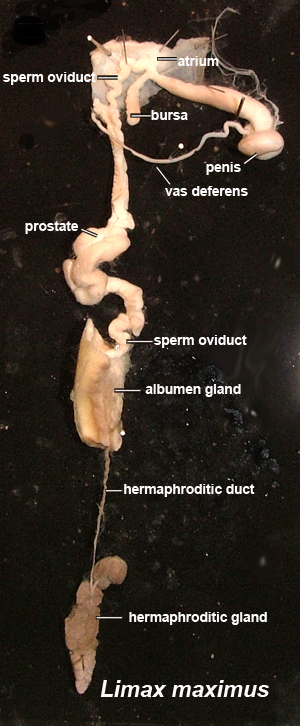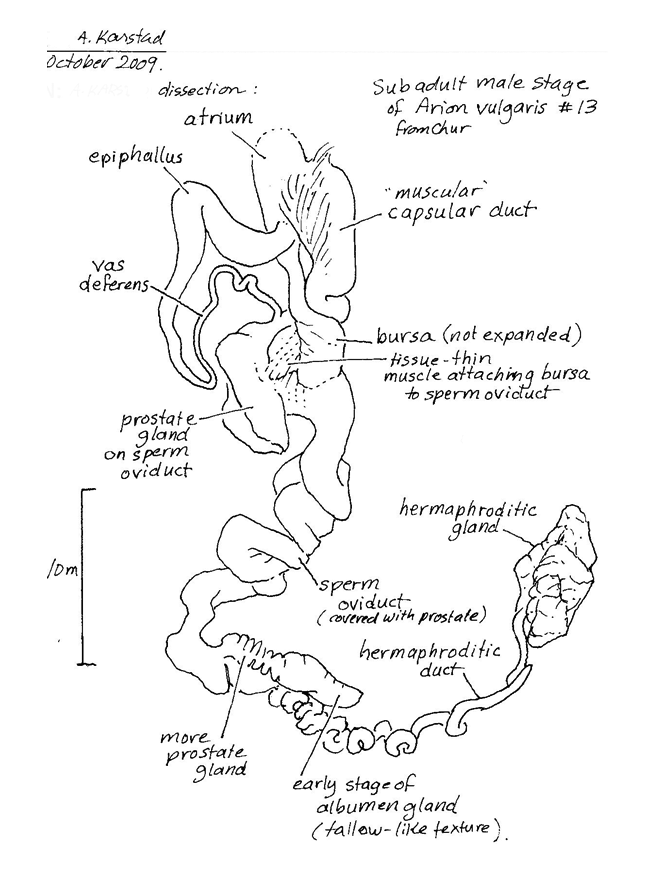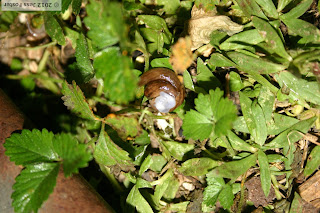 |
| © 2009 Aleta Karstad |
 |
| © 2009 Aleta Karstad |
The hermaphroditic gland can also be referred to as the hermaphroditic gonad or, as I will call it, the ovotestis. As its name implies, the ovotestis produces both eggs and sperm. Before a slug can mate, the sperm must first travel the hermaphroditic duct, making its way through the albumen gland to the spermoviduct. It matures in the prostate and then enters the narrow vas deferens, or sperm duct, which transports the sperm to the penis. After a slug donates its sperm and receives a mass from its partner, the received sperm is first stored in the seminal receptacle, or bursa copulatrix. There, part of its cuticle (encasing) is dissolved before it's released to travel back down to the fertilization chamber at the end of the spermoviduct. The eggs come up from the ovotestis, are affected in some way by the albumen gland, and then enter the fertilization chamber where the sperm is. The sperm fertilizes the eggs. The fertilized eggs travel up the spermoviduct and enter a capsular duct. There, the eggs get their shape. Before the slug lays the eggs, ejecting them through the gonopore, they receive their protective shells.
If you recall, I've hypothesized that L. valentiana engages in external sperm exchange. Although, after further study, I'm still unable to draw a conclusion from the data, I haven't found any evidence to actually disprove my hypothesis, so it will stand for now. The penes emerge just after the appendices have extruded to their full extent. This occurs "explosively," as Reise would put it. They instantly entwine around each other, perhaps removing sperm from the partner's penial appendix or depositing sperm on it, or exchanging sperm directly; in any case the task is accomplished in a matter of seconds. During copulation, the slugs usually retract their tentacles and raise their mantles. In some of the photos, the penes appear to have a white segment: could this be a sperm mass about to be delivered?
Again, it might be helpful to compare these photos to videos of other species mating:
http://www.senckenberg.de/files/content/forschung/abteilung/zoologie/malakologie/malak/hutch/malta.htm#truepan_cop
http://www.senckenberg.de/files/content/forschung/abteilung/zoologie/malakologie/malak/reise/ss.htm
Unlike the slugs in the above videos, those of L. valentiana don't seem to have any trouble separating their entwined penes; they don't have to pull away or bite at them. It's a very smooth process.
Couple 11:
 |
| Penes not fully extended, either emerging or retracting. |
 |
| My inadvertent shadow allows you to see that each penis tapers to a point. I believe this may be a late stage of copulation, where the penes are being retracted. |
 |
| After retraction. |
Couple 17:
Couple 20:
Couple 21:
The next photo made me wonder if the slugs aren't mating by intromission. If the base of the penis (see caption below) is visible, then that means the organ is fully extended. Now, both penes could be fully extended and externally entwined but hidden from view in this photo, or each could have been inserted in the partner's gonopore. However, the penis of this species is so large that I doubt the slug's ability to insert it into the pore. Thus my hypothesis stands.
Couple 24:
 |
| Look how the mantle becomes folded, arching upward. You can see inside it. |
Couple 25:
 |
| Notice how the lower slug's neck and head have twisted out of its mantle, so they're not aligned as normally. |
Couple 26:
 |
| As the penes are retracting, you can see again the tapered point. |
Despite all this data, I'm left with multiple questions about copulation and reproduction in Lehmannia valentiana. I will pass on to you new photos and discoveries as they come. In the next post I'll provide another set of photos with emphasized contours so you can better distinguish the genitalia.
















free jav Live Porn Video
ReplyDelete